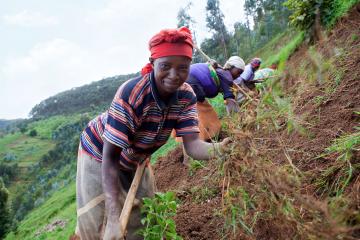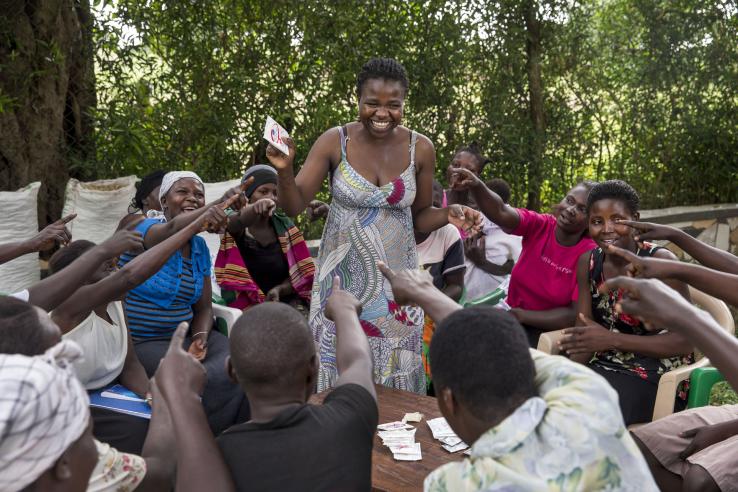
What works to enhance women’s agency: Lessons from a new literature review

In order to identify emerging lessons on the most effective approaches to improving women’s agency, J-PAL undertook a literature review of 160 experimental and quasi-experimental studies in lower- and middle-income countries (the main findings are also summarized in our evidence review).
In honor of International Women’s Day this week, we are highlighting insights from this review and sharing ideas for further research.
Why study women’s agency?
A growing body of evidence, including from J-PAL affiliated researchers, evaluates programs that actively seek to shift gender norms (informal rules that impose expectations about behavior that are dependent on gender) or improve women’s agency (their ability to define and act on goals, make decisions that matter to them, and participate in the economy and public life).
For example, a study in India led by Gender sector chair Seema Jayachandran and co-authors found that encouraging students to discuss gender equality in the classroom positively impacted adolescents’ gender attitudes and encouraged gender equitable behaviors.
The goal of our literature review, supported by the Bill & Melinda Gates Foundation, was to synthesize the evidence from this and other such studies, to gain insights on what works to enhance women’s agency.
Because gender gaps that impair women’s ability to make choices for themselves exist in many areas of life, women’s agency can be exercised in countless ways. Given this, we adopted a broad definition of agency in the literature review that included both direct and indirect indicators, building on previous work by Kabeer (1999), Malhotra, Schuler, and Boender (2002), Quisumbing, Rubin, and Sproule (2016), Donald et al. (2017), and Laszlo et al. (2017).
In our list of direct indicators, we included outcomes that are fundamental to a woman’s ability to make meaningful choices and act on them, such as decision-making power, psychological elements of agency (termed “power within”), freedom of movement, and freedom from violence.
We also included indirect indicators, which are outcomes and behaviors that often reflect a woman having more agency, including the timing of marriage and childbearing, contraceptive use, labor force participation, income generation from entrepreneurship, participation in politics and community decision-making, voting behaviors, and participation in groups and ties in the community.
Major trends
The literature review begins with an analysis of patterns in these direct and indirect indicators of agency across 160 experimental and quasi-experimental studies.
Overall, the evidence suggests that policymakers, practitioners, and researchers should be more intentional when it comes to addressing power imbalances and social inequalities based on gender by designing programs that directly address attitudes about gender. The major trends we identified are:
- Gender norms moderated—or even blocked—impacts: Many studies found that regardless of whether or not gender dynamics were considered in the program or research design, they may end up playing a meaningful role in moderating or even blocking the intended impacts.
- Access doesn’t equal control: Access to resources alone—while important for reducing gender gaps in access—is often not an effective means to enhance women’s agency without addressing gender-specific constraints faced by women.
- Opportunities to enhance women’s agency change throughout a woman’s life: Based on the studies we reviewed, there tended to be more significant impacts in programs aiming to support young women in delaying marriage and childbearing than in programs that aimed to change household decision-making dynamics within a marriage, perhaps because women did not have good outside options.
- Programs to address multiple constraints were promising but need more research: While programs designed to relieve multiple constraints that women face—such as lack of access to financial resources, lack of skills, or gender norms that favor men—appeared to be effective in improving women’s agency, more research is needed on why the programs were effective, and whether the full packages of services were necessary. These programs often included elements that raised awareness of gender dynamics or developed life skills.
Some key takeaways
Beyond these findings, we also identified a range of takeaways specific to each indicator of agency that we reviewed. Here are examples of some of the findings. We have listed one example finding from each section—click through for more details and to read more takeaways from each section of the review:
Direct indicators of agency:
- “Power within” (a term that includes aspirations; self-efficacy, or belief in one’s ability to achieve goals; and attitudes towards gender norms): Adolescent girls’ programs that included soft and life skills training, sometimes bundled with other interventions, improved girls’ self-efficacy, confidence, and reduced their acceptance of restrictive gender norms.
- Household decision-making: The economic interventions we reviewed (microcredit, savings, unconditional transfers, and multi-component poverty alleviation programs) had mixed and inconsistent impacts on women’s household decision-making. However, a small number of studies found that improving property rights laws and the justice system’s capacity to address domestic violence improved women’s influence over family decisions. There are also key issues with how researchers measure decision-making, which we discuss in a later section.
- Freedom of movement: Most studies in which an intervention improved freedom of movement did not identify how exactly this effect occurred. However, two studies found that increasing women’s power in the home through control over financial resources was also effective in improving women’s freedom of movement, suggesting that this channel should be explored further.
- Freedom from violence: Women’s access to cash and food transfers decreased experiences of intimate partner violence in the short run (though one study documented increases in emotional violence for some women). Reducing poverty-related stress and tolerance for violence are potential explanations for these impacts. Access to microcredit, savings groups, or employment did not lead to similar results.
Indirect indicators of agency:
- Timing of marriage and childbearing: Overall, interventions that changed perceptions about girls’ abilities and opportunities or increased the educational and economic opportunities available to them encouraged girls and young women to delay pregnancy.
- Contraceptive use: Giving women more direct control in family planning by providing privacy, life skills training, more options in contraceptive products, or encouraging more gender-equitable attitudes among men increased women’s agency in contraceptive use.
- Labor force participation: Providing access to free or subsidized childcare increased women’s labor market participation in Indonesia, Kenya, and parts of Latin America.
- Income generation from entrepreneurship: Business training programs varied greatly in program design and had mixed impacts on earnings. Successful programs often included gender equality content or addressed gender specific constraints such as agency, soft skills, or social networks.
- Participation in politics and in community decision making: The "Graduation” approach increased women’s participation in politics and community decision-making in several contexts.
- Voting behaviors: There is suggestive evidence that information sharing programs which aimed to encourage voting among women were not successful due in part to restrictive gender norms.
- Participation in groups and ties in the community: Several studies suggest that women’s self-help groups either increased or strengthened women’s ties in the community and participation in other groups in South Asia.
Overall, we found that adolescent girls’ programs, laws that mandate gender equality, cash and in-kind transfer programs, and BRAC’s multi-component poverty alleviation program (called the “Graduation" approach) were effective in improving one or more aspects of women’s agency.
The literature review also includes notes on impacts of interventions that engage men, and on the challenges of measuring women’s agency, along with an appendix detailing each study we included and the metrics we used for broad indicators like “power within,” household decision-making, and violence against women.
Future research
While we covered a range of outcomes in this review, there are still areas that merit further research and synthesis. A better understanding of how characteristics like race, class, ethnicity, national origin, ability, sexual orientation, religion, and gender identity affect the impacts of policies and programs will further improve our understanding of how to enhance women’s agency.
J-PAL affiliates are evaluating a range of exciting new projects that attempt to actively shift gender norms and change gender-related power dynamics.
For example, a study led by Erica Field and co-authors evaluates the impact of training local leaders to shift attitudes about gender-based violence in Peru, and a study led by Elise Huillery and co-authors evaluates the impact of youth clubs designed to change young people’s attitudes towards gender norms in Niger—these are just a few examples of how our affiliates are charting new ground in rigorous research to improve gender equality.
Continuing to research and understand approaches that are designed to shift—rather than accommodate—individual and collective gender norms that perpetuate inequality is a priority for policymakers and practitioners seeking to achieve gender equality. At J-PAL, we will continue to focus on enabling this innovative research in more settings, and will share new findings and policy insights as they develop.

